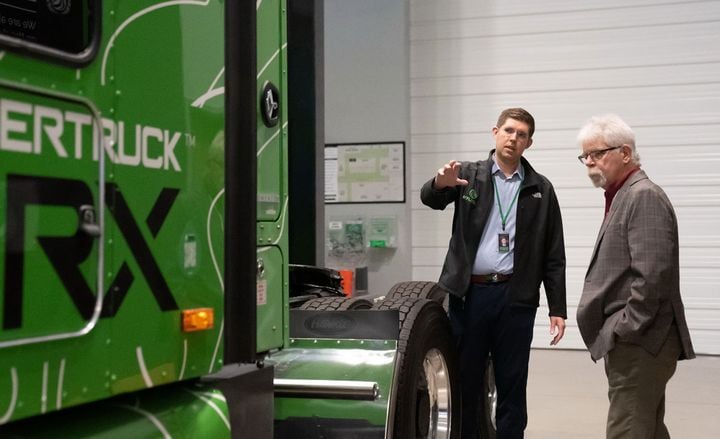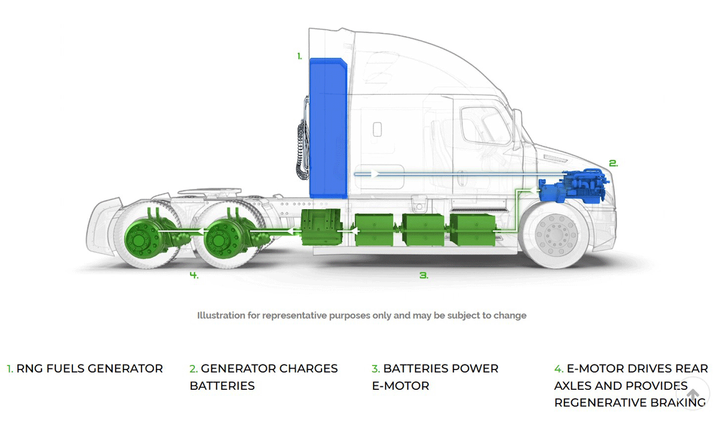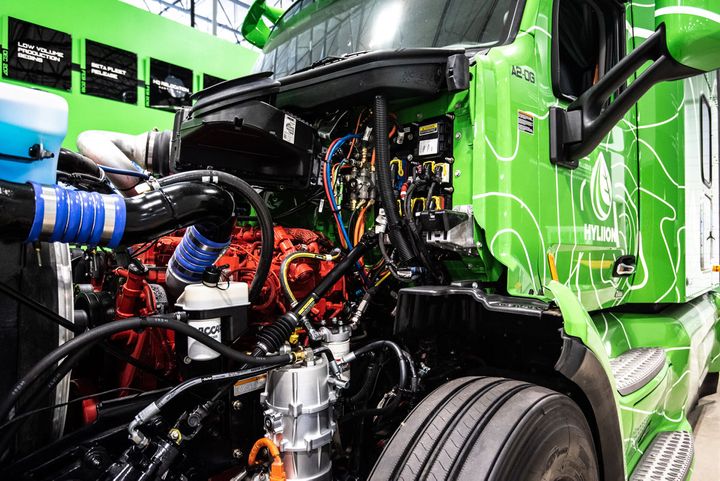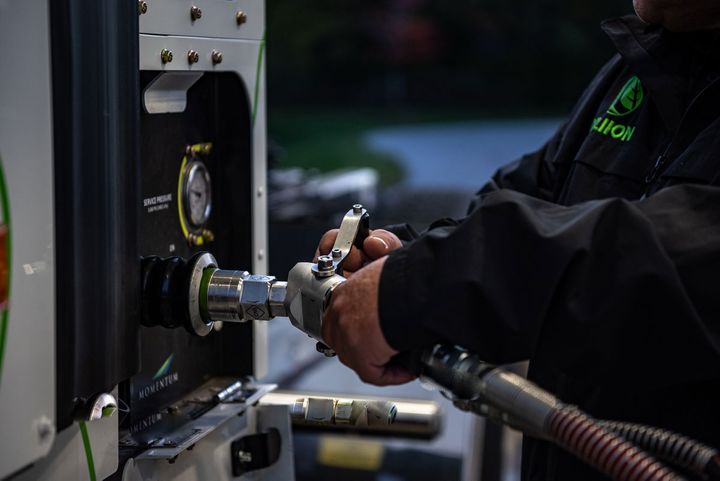Trucker Access › Forums › Diesel News › Hyliion’s ERX Hypertruck: A Here-Now Solution to BEV Range Problems – Equipment
- This topic has 0 replies, 1 voice, and was last updated 11 months, 1 week ago by
 EazyRiDer66.
EazyRiDer66.
-
AuthorPosts
-
May 17, 2024 at 6:15 am #20842
 EazyRiDer66Keymaster
EazyRiDer66Keymaster

Hyliion’s natural-gas-powered ERX Hypertruck is the first step in a journey toward a fuel-cell-powered zero-emissions transportation solution.
The Dec. 20 release of the Environmental Protection Agency’s final rule on diesel engine emissions brings into pretty sharp focus the need to explore alternatives to diesels. The pathway to an all-electric future is beginning to take shape, but pure-electric long-haul trucks are still a long way out.
Stiffening emissions standards will drive both cost and complexity. While much of the responsibility for adhering to these standards will fall on the truck and engine makers, fleets will share that burden, with higher costs and likely additional maintenance procedures. (Hopefully it won’t be as bad as when fleets became technology guinea pigs after 2007 emissions standards went into effect.)
Is there such a technology on the horizon, one that’s somewhere between diesel and fully electric, that meets industry needs while checking all the environmental boxes? It might be Hyliion’s Hypertruck ERX.
I suspect Hyliion founder and CEO Thomas Healy and his crew are dancing a jig at their headquarters in Austin, Texas. EPA’s new emissions rule establishes the ERX Hypertruck technology as at least a safe haven during the roll-out of the new rules, as it already exceeds the new NOx reduction standards.
Hyliion had invited me to Austin for a spin in the Hypertruck ERX back in the spring, but with scheduling conflicts, I finally got there at the end of November. (Full disclosure: Hyliion paid for my airfare and fed me a box lunch while I was in Austin.)
The truck I drove was a pre-production version of the ERX Hypertruck. I was told it’s better than 90% production ready.

Hyliion Founder and CEO Thomas Healy (left) gives HDT Equipment Editor Jim Park a walk-around tour of the ERX Hypertruck at the company’s corporate headquarters in Austin, Texas.
ERX Hypertruck Explained
ERX is a fully electric, battery-powered drivetrain kept charged by a natural-gas-powered generator, sometimes called a range extender. ERX is a significant step toward decarbonization using an energy source that’s already cleaner and less expensive than diesel. This solution offers essentially unlimited range, and there’s no upfront infrastructure cost, unless a fleet wants to install in-yard fueling facilities.
The truck has tandem drive axles, each powered by an independently controlled electric motor with a two-speed gearbox. The motor/gearbox assembly is mounted on the front of the differential housing where we’d typically find a driveshaft. The motors are powered by a pair of saddle-mounted batteries.
Those batteries are charged by a Cummins ISX12N natural gas engine with no direct link to the drive axles. There’s an electric generator mounted on the back of the engine where the transmission usually goes. The engine is fueled by four compressed natural gas storage tanks with a diesel-gallon equivalent capacity of 175 gallons, which gives the truck a range of about 1,000 miles.

Natural gas stored in the back-of-cab storage tanks fuels the range extender engine, which charges the batteries. Batteries power the e-axle motors to drive the truck. The drivetrain is 100% electric.
Running only on batteries, with the generator shut off, the truck has a range of about 75 miles. That’s sufficient to operate in emissions abatement areas or at night in areas where noisy diesels are frowned upon.
The ERX powertrain is simple enough in concept, but pretty complex in execution. There’s a lot of calculating and computing going on in the background to maintain the optimal battery charge. Since the truck also takes advantage of regenerative braking, the engine-powered generator can stand down and let momentum charge the batteries when braking or descending grades.
It has a predictive charging system where, through terrain mapping, the truck knows ahead of time where charging opportunities are and so will let the battery charge drop lower than usual to capture as much free energy as possible when it can. The system can be geofenced to ensure it only operates in EV-mode at certain locations, such as in cities, at warehouse facilities, etc. In this case, the system would automatically maximize the battery charge to extend the EV-mode range.
What’s in the Box?
The truck I drove was an off-the-shelf Peterbilt Model 579 — minus the traditional driveline — with few obvious modifications to the cab or driver interface. Instead, the ERX powertrain features Meritor’s Blue Horizon 14Xe integrated e-axle drive axles as the standard position propulsion and regeneration hardware.
The Cummins ISX12N natural gas engine is basically a stock engine, but most of the accessory drives, such as the power steering pump, air compressor and cooling fans, are all powered electrically off the battery so they will continue running when the engine is shut off in EV-mode.
The electrics demand little additional maintenance, while the ISX12N requires the usual oil and spark plug changes at specified intervals. The truck also has an all-electric HVAC system that is essentially maintenance-free for idle-free and noise-free operation.

The powerplant of choice right now is Cummins’ ISX12G natural gas engine. Hyliion says when Cummins readies the X15G engine, it’s next under the hood.
The engine uses the standard maintenance-free three-way catalyst aftertreatment system found on other natural gas engines, and it already exceeds EPA’s newly published low-NOx emissions standard. If you are unaware, that’s 80% lower than the current EPA standard for diesel engines.
The truck I drove had four compressed gas tanks (175 DGE) mounted behind the sleeper. That can be scaled back to three or two tanks (65 DGE) to save weight if range isn’t a big concern.
There’s almost no difference from the driver’s perspective. The cab and dash layout are the same as a diesel Model 579. The function of the truck is identical, too. The familiar shifter stick on the steering column is used to shift into forward or reverse, and to control the level of regen braking intensity requested by the driver, in much the same way the shifter control is used on a diesel.
The truck had a prototype tablet display mounted above the sun visor over the driver to show the battery state of charge and other pertinent details about the system. That tablet will eventually be integrated into an in-dash display with yet-to-be-determined functionality. The driver will have access to some functions of the charging system and battery-only operation but not all.
Hyliion Founder and CEO Thomas Healy gave me a walk-around tour of the truck and accompanied me on the drive, giving me lots of opportunity to ask questions. He answered most of them but was mum on a few points. In fairness, it’s still in development, so some specs might change before production begins.
When asked about weight, he said, coyly, “It is lighter than a full BEV but heavier than a diesel.”
Driver Appeal
I’m afraid I don’t have anything terribly exciting to report here; the ERX Hypertruck drives just like any other Peterbilt 579, with a couple of exceptions. It’s really quiet in in the cab, even with the range extender engine running. And with a total of 670 hp at the wheels, it pulls better than almost any truck I have ever driven.
We know drivers aren’t fond of natural gas engines, but they love battery-electric trucks for their power and get-up-and-go. Here’s the beauty of the ERX. In a typical driving scenario, flat ground, open road, the truck needs about 125 to 150 hp (like almost any modern aero truck) to maintain 65 mph or so. The natural gas engine pushes about 200 hp through the generator and into the batteries. There’s a positive flow of electricity to the batteries anytime the state of charge is between 50% and about 80%.
However, if the driver gets on the throttle for a climb or a passing maneuver, output isn’t limited to the natural gas engine’s lame 400 hp/1,450 lb-ft, The driver has a full 670 electric hp and gobs of torque under foot. The depleted charge from that additional push is easily made up by the generator or regen braking opportunities.
When accelerating up a freeway onramp, as I did at one point, I could feel the motors changing gears — though Thomas my co-pilot had to point it out as it was happening. As one of the two drive motors broke torque and shifted to high gear, the other motor kept powering the other drive axle. When the first shift was complete, the second motor/gearbox shifted to high gear, and we kept accelerating with no pause for the gear change.
On the other end of the electric spectrum, regen braking was as strong or stronger than even a diesel engine brake. I was able to manage the intensity of the braking (energy capture) with control on the steering column, from position 1 (mild) to position 3 (full). In a skilled driver’s hands, this could easily be a one-pedal truck, with almost no need to ever touch the brake except to hold the truck still at a traffic light.
The in-cab noise level in battery mode was about 10 decibels quieter than a diesel. The difference is about the same as a typical diesel at highway speed compared to a fairly nice passenger car.
It was a bit louder with the generator engine running, but it was less obtrusive than a reefer engine. In fact, in some ways it was a lot like a reefer engine, cycling on and off and changing speed with charging demand. The difference was the sound was coming from the front rather than behind the cab.
It was a bit odd accelerating and decelerating with no difference in the sound of the engine. When it was running, it ran at a fairly constant speed regardless of what the truck was doing. But I think most drivers would get used to that after a day or two of driving an ERX.
Pros and Cons of Natural Gas
In some people’s eyes, natural gas is still a carbon-based fossil fuel, and that’s enough of a reason to condemn the stuff. However, it’s cleaner-burning than diesel. It’s much less expensive; it requires a very simple, no-touch aftertreatment system, and it already meets the ultra-low NOx and particulate matter (PM) standards that are causing consternation and gnashing of teeth between the engine makers and the regulators.
The U.S. Department of Energy says burning a million BTUs worth of natural gas produces about 117 pounds of CO2, compared to 160 pounds for a similar amount (energy content) of diesel.
Further, when you factor in the growing potential for renewable natural gas made from biomass, organic waste, manure ponds, etc., the emissions reduction proposition becomes even better.

The natural gas fueling network is already well established, with more than 700 locations presently serving trucks. Natural gas corridors cover every major truck lane in the U.S.
Chemically, RNG is nearly identical to “natural gas.” Landfill gas and manure pond gas contain potent forms of methane and are greater contributors to global warming than carbon dioxide, one of the byproducts of diesel fuel combustion we’re trying so hard to curb.
By capturing and burning that methane as a fuel to produce electricity, we not only displace the CO2 produced by diesel fuel when used to power a truck, we also prevent the more potent methane from escaping into the atmosphere. This allows renewable natural gas to be classified as having a negative carbon intensity.
Hyliion makes a big deal out of using RNG. That’s a bit disingenuous, I think, unless they are tanking up at a dedicated RNG producing facility. In truth, RNG is typically sold to natural gas distributors, where it displaces a certain amount of fossil natural gas in those pipelines. However, there are many dedicated sources of retail RNG. In California, for example, more than 90% of the natural gas consumed as a transportation fuel is RNG.
The other big positive Hyliion’s ERX Hypertruck has going for it is that it is here. Now. No waiting a decade for the grid to catch up to demand. No need to upgrade truck terminals with high-voltage power supplies. And the fueling network is well-established along most busy truck corridors.
Hyliion completed its summer testing a few months ago in Laughlin, Nevada. The testing and evaluation crew is heading to Minnesota in the New Year to conduct cold-weather testing. Hyliion is now doing controlled fleet trials, and after evaluating fleet feedback, it expects to begin production of the ERX Hypertruck late in 2023 or early 2024.
-
AuthorPosts
- You must be logged in to reply to this topic.